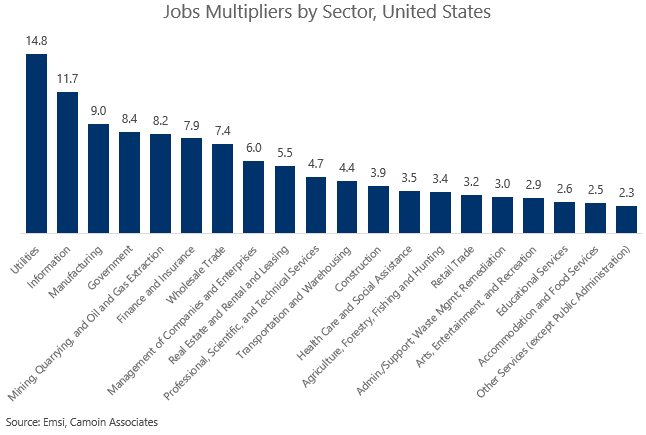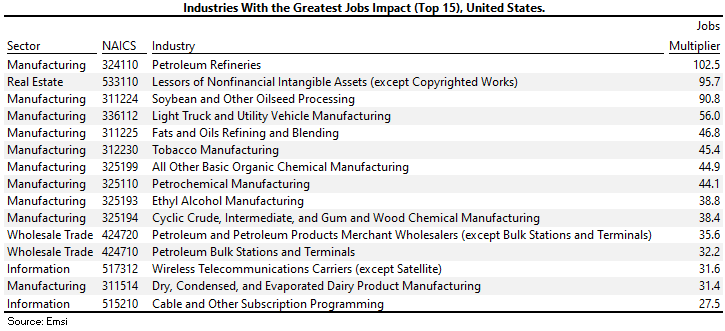- Navigator
- Economic and Fiscal Impact Analysis
- National

Understanding the importance of different industries to the local economy has become increasingly important to economic development organizations. With limited resources, economic development professionals may consider how can they get the biggest return on their investment. Economic multipliers are one tool that can be used to help with this.
Each industry is linked to other industries that (1) provide the materials and inputs needed and (2) where the industry’s workers spend their income. This means that in addition to the direct jobs within and industry, there are indirect and induced jobs that are also supported by an industry. Multipliers can be used to quantify the indirect and induced impact of activity in an industry, and are one way to identify industries that play the largest role in your overall economy.
Types of Economic Multipliers
Multipliers are industry specific and are generally available and used at the most specific 6-digit NAICS industry level. There are three types of economic multipliers that can be used to measure the ripple effects of an industry:
- Jobs Multipliers: Indicate how important an industry is in regional job creation. A multiplier of 3.0, for example, would mean that for every job created by that industry, two other jobs would be created in other industries (for a total of 3 jobs).
- Earnings Multipliers: Indicates the amount paid out in wages, salaries, and other compensation throughout the economy for every new dollar of earnings generated. A multiplier of 2.3 for example means that for every $1.00 dollar of earnings paid in an industry, $2.30 of earnings (wages, salaries, and other compensation) is generated throughout the economy.
- Sales Multipliers: Indicate how deeply rooted an industry is in the region. A high sales multiplier indicates that every new dollar in the industry will have a high ripple effect in the regional economy before leaking out.
This article focuses specifically on jobs multipliers.
Which industries have the biggest ripple effect?
Nationally, industries in the Utilities sector have the highest jobs multiplier among all sectors.[1] This means that the creation of jobs in the Utilities sector will result in the creation of more indirect and induced jobs than any other sector. In addition to Utilities, the Information and Manufacturing sectors all have jobs multipliers of at least 9.0. This means that, on average, the addition of a job in one of these sectors will result in the creation of at least nine total jobs in the national economy.

Among specific industries, Petroleum Refineries have the largest jobs impact, with 102.5 total jobs in the national economy associated with every one job in the industry. Industries with a high sales-to-labor ratio typically have a high jobs multiplier due to the large amount of investment in equipment, materials, and other inputs needed. Manufacturing accounts for 10 of the 15 industries with the largest jobs multipliers are in the manufacturing sector. Real Estate, Wholesale Trade, and Information are also represented.

What does this mean for you?
- Jobs multipliers are one tool that can be used to assess the impact of a change in an industry (either positive or negative) on a community and can help decision makers who are considering financial assistance or targeted attraction efforts.
- Multipliers are available, and most useful, when applied locally. Camoin Associates’ source for multipliers and impact modeling and an industry leading data provider, Emsi, provides multipliers for 6-digit industries down to the ZIP code level.
- High jobs multipliers could indicate that a change in an industry will have a significant impact on your community’s economy. This can help communities prioritize industries to target for growth, however when doing so it is important to understand this in terms of investment required and other economic variables.
- In addition to jobs multipliers, Camoin Associates’ economic impact analyses use earnings and sales multipliers to assess the economic impact of a project on a community. For more information on our recent economic impact projects see: Nassau County Industrial Development Agency – Economic Impact Dashboard, Economic and Fiscal Impact of Film Fax Credits: New York State, and Economic and Fiscal Impact of Portland Foreside Mixed-Use Development, or click the link below.
economic Impact Analysis Services
[1] Source: Emsi. Multipliers are available at the 6-digit level. Sector-level multipliers are a weighted average of multipliers of all 6-digit industries in that sector.
Image Source: Koen Emmers on Unsplash






